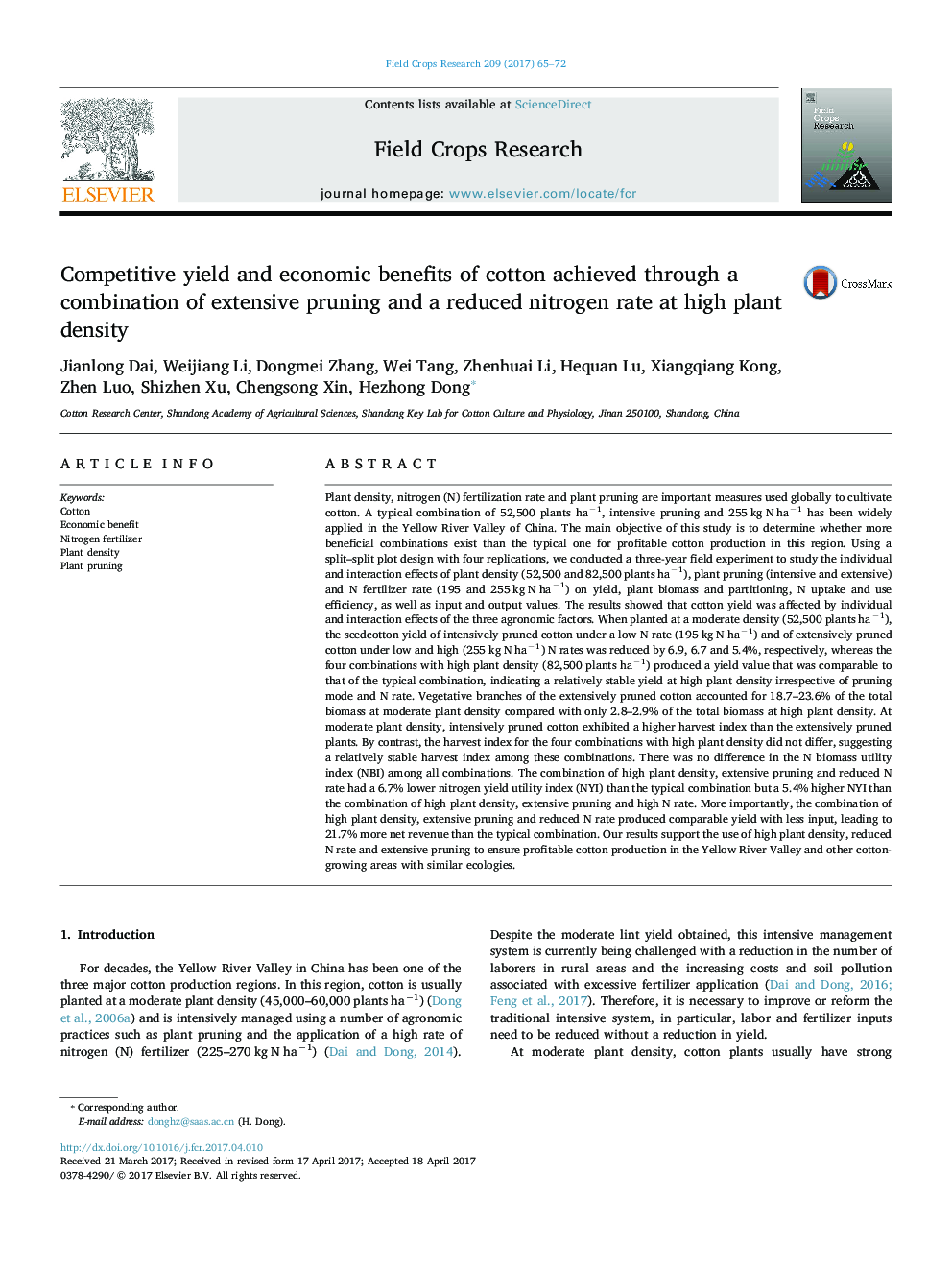| کد مقاله | کد نشریه | سال انتشار | مقاله انگلیسی | نسخه تمام متن |
|---|---|---|---|---|
| 5761503 | 1624654 | 2017 | 8 صفحه PDF | دانلود رایگان |
عنوان انگلیسی مقاله ISI
Competitive yield and economic benefits of cotton achieved through a combination of extensive pruning and a reduced nitrogen rate at high plant density
ترجمه فارسی عنوان
عملکرد رقابتی و مزایای اقتصادی پنبه به وسیله ترکیبی از هرس گسترده و کاهش میزان نیتروژن در تراکم بالای گیاه حاصل شده است
دانلود مقاله + سفارش ترجمه
دانلود مقاله ISI انگلیسی
رایگان برای ایرانیان
کلمات کلیدی
پنبه، مزایای اقتصادی، کود نیتروژن، تراکم گیاه هرس گیاه
موضوعات مرتبط
علوم زیستی و بیوفناوری
علوم کشاورزی و بیولوژیک
علوم زراعت و اصلاح نباتات
چکیده انگلیسی
Plant density, nitrogen (N) fertilization rate and plant pruning are important measures used globally to cultivate cotton. A typical combination of 52,500 plants haâ1, intensive pruning and 255 kg N haâ1 has been widely applied in the Yellow River Valley of China. The main objective of this study is to determine whether more beneficial combinations exist than the typical one for profitable cotton production in this region. Using a split-split plot design with four replications, we conducted a three-year field experiment to study the individual and interaction effects of plant density (52,500 and 82,500 plants haâ1), plant pruning (intensive and extensive) and N fertilizer rate (195 and 255 kg N haâ1) on yield, plant biomass and partitioning, N uptake and use efficiency, as well as input and output values. The results showed that cotton yield was affected by individual and interaction effects of the three agronomic factors. When planted at a moderate density (52,500 plants haâ1), the seedcotton yield of intensively pruned cotton under a low N rate (195 kg N haâ1) and of extensively pruned cotton under low and high (255 kg N haâ1) N rates was reduced by 6.9, 6.7 and 5.4%, respectively, whereas the four combinations with high plant density (82,500 plants haâ1) produced a yield value that was comparable to that of the typical combination, indicating a relatively stable yield at high plant density irrespective of pruning mode and N rate. Vegetative branches of the extensively pruned cotton accounted for 18.7-23.6% of the total biomass at moderate plant density compared with only 2.8-2.9% of the total biomass at high plant density. At moderate plant density, intensively pruned cotton exhibited a higher harvest index than the extensively pruned plants. By contrast, the harvest index for the four combinations with high plant density did not differ, suggesting a relatively stable harvest index among these combinations. There was no difference in the N biomass utility index (NBI) among all combinations. The combination of high plant density, extensive pruning and reduced N rate had a 6.7% lower nitrogen yield utility index (NYI) than the typical combination but a 5.4% higher NYI than the combination of high plant density, extensive pruning and high N rate. More importantly, the combination of high plant density, extensive pruning and reduced N rate produced comparable yield with less input, leading to 21.7% more net revenue than the typical combination. Our results support the use of high plant density, reduced N rate and extensive pruning to ensure profitable cotton production in the Yellow River Valley and other cotton-growing areas with similar ecologies.
ناشر
Database: Elsevier - ScienceDirect (ساینس دایرکت)
Journal: Field Crops Research - Volume 209, 1 August 2017, Pages 65-72
Journal: Field Crops Research - Volume 209, 1 August 2017, Pages 65-72
نویسندگان
Jianlong Dai, Weijiang Li, Dongmei Zhang, Wei Tang, Zhenhuai Li, Hequan Lu, Xiangqiang Kong, Zhen Luo, Shizhen Xu, Chengsong Xin, Hezhong Dong,
